9 /10 1 Votes
Initial release date 1998 Publisher Lucas Learning Mode Single-player video game | 4.5/5 Amazon Developer Lucas Learning Genre Adventure game | |||||||||||||||||||||||||||||||||
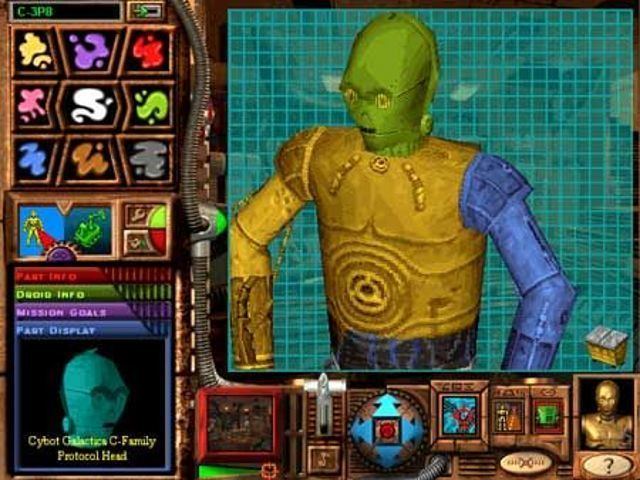 | ||||||||||||||||||||||||||||||||||
Similar Star Wars: Yoda Stories, Star Wars: Force Commander, Star Wars: Yoda's Challenge, Star Wars: Super Bombad, Star Wars: Rebel Assault II | ||||||||||||||||||||||||||||||||||
Star Wars: DroidWorks is a 1998 educational adventure video game, and the premiere edutainment title of LucasArts subsidiary Lucas Learning. It was built from the same engine as LucasArts' Star Wars: Jedi Knight. The creators aimed to make a program that appealed to both genders, and designed it to avoid violence. The release date was moved up by a number of months, resulting in the development team having to cut some of the game's features.
Contents
- Conception
- Design
- Release
- Plot and gameplay
- Reception
- Commercial performance
- Awards and accolades
- References
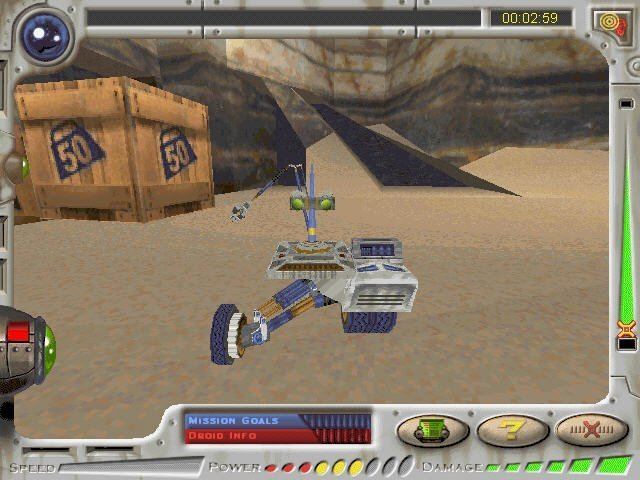
The game's plot involves the player saving the galaxy by manufacturing droids that can complete secret missions based on certain specifications such as the ability to see in the dark or to jump. These missions are where the educational properties come into play, as the missions puzzle specifies, it will teach the player about energy, force and motion, simple machines, light, and magnetism.
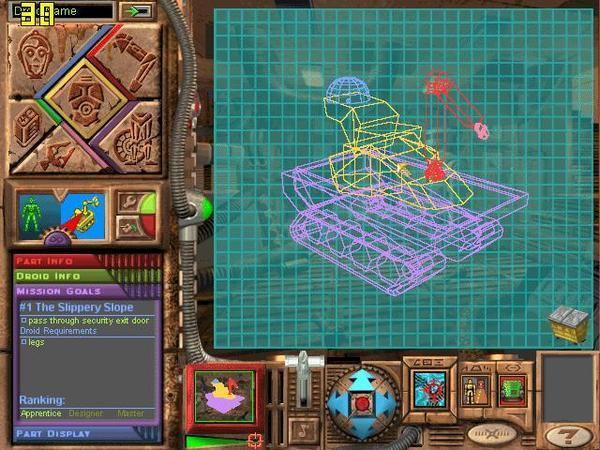
Star Wars: DroidWorks was met with high praise from critics, sold very well, and went on to win a number of awards and accolades.
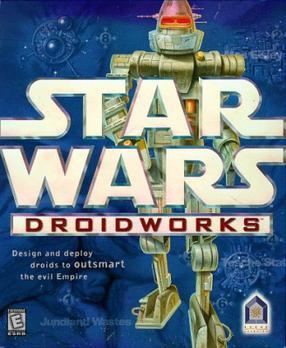
Conception
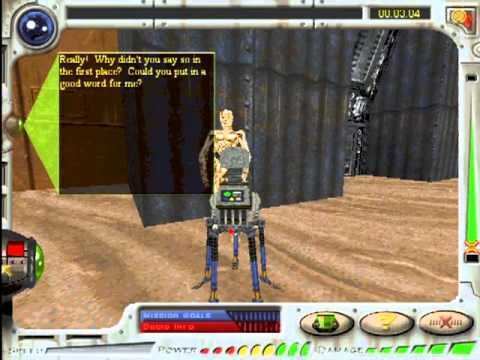
The game was developed by LucasArts subsidiary spin-off Lucas Learning. The company had originally been created to produce consumer products, but was reimagined as a developer of direct-to-school curriculum products in the fall of 1998. This marked George Lucas' first foray into the edutainment space. Star Wars DroidWorks was the premiere title of Lucas Learning, and one among a series of Star Wars games to be released their new sweep of edutainment titles. The title was also one out of 175 created by third party software developers for the newly launched iMac platform. Lucas' directive to the company was to design a game that would allow players the freedom to explore and create like Erector Sets and Legos. The initial concept was thought up by project leader Collette Michaud. who pitched a game where players could design their own Star Wars droid and watch them animate.
General manager of Lucas Learning Susan Schilling said that Droidworks did not require the player to use bombs or guns to progress, noting that the only weapon required is the player's mind. The team had a concerted effort to make the game equally appealing to girls and boys; recent research had shown that both genders liked interactive software and like to "make their own story" so they wanted the program to be able to encourage girls to become better at maths, science, and computers. The player's decision-making and curiosity would lead to their progress in the game. In a press release, Lucas Learning described their game as a "unique combination of construction set and strategy game". Susan Schilling and senior director of worldwide developer relations at Apple Computer Clent Richardson agreed that the Apple Mac was the best platform to play the game on. The development team sought aid from both a Kid Advisory Group and Subject Matter Experts, in order to make a game that was both appealing to young gamers and scientifically factual.
Design
The game used an audio soundscape that shared similarities to those of the film series, and also included clips taken from the preceding trilogy. It used the same first-person shooter game engine used in many of LucasArts's contemporary titles. The game was built from the same engine as LucasArts' Star Wars: Jedi Knight, although the software had to be edited for various reasons, the main one being that while Jedi Knights had used an elastic form of physics, DroidWorks had to be true to the real world. While the Star Wars universe was known for its wars and violence, the design team made it a philosophy to use as little violence as possible; this led to create ways to prevent the player from accessing certain levels until a particular point. For instance rather than putting enemies in their way which could only be defeated once the player's droids had enough strength to defeat them, the landscape itself would be designed so only certain types of droids could traverse to the puzzle, which had the bonus effect of weeding out players who had not yet acquired the required parts to successfully complete the level. While the developers planned a "luxurious" development schedule which culminated in the game's release in Christmas 1998, the marketing department thought the game should be released for Labour Day instead; this new focus meant that various cuts had to be made to the design. Ultimately the game passed the Labour Day deadline and was released in October. One of the cut features would have allowed players to place droid parts in locations other than where they were intended to fit, for instance an arm could be attached to a droid's head.
Release
The game was demoed at the 1998 Macworld Expo. In June 1998, The Washington Times reported the game was set to be released on Macintosh and PC in September of that year. It would eventually be released on October 21, 1998. The game was made available directly to schools, along with other edutainment titles by Lucas Learning. In March 1999, the game was "currently available wherever software is sold". In June 1999, the game was noted as being being sold at two-store specialty groups. The game was marketed and packaged as an entertainment title, and was advertised in gaming magazines and Family PC. While the developers thought the game blurred the line between entertainment and education, this originally presented an issue for the marketers as they had to make a decision whether to place the game on the clearly divided "game" and "education" shelves; it helped that Lucas Learning were able to leverage LucasArts' success and the Star Wars name to get into retail stores such as Walmart and Costco.
Plot and gameplay
On Tatooine, there is a droid factory that the Galactic Empire has set up, So the rebellion sends C-3PO and R2-D2 and you, a rebel agent disguised as a Jawa to complete missions leading to the secret droid factory and to reprogram the evil droid army, but first, you must win the trust of your fellow Jawas. To proceed to the droid factory, the player must complete eight training missions and four top-secret missions with task-specific requirements, Such as 'Droid must be magnetic, Droid must be able to see in the dark, or Droid must weigh less than 100 kilograms. This allows you to complete the mission. Through experiential learning, players learn about and apply the scientific principles of energy, force, light, engineering, and magnetism. In addition, the game encourages players to apply math, logic, and critical thinking skills. The game contains 87 droid parts which can be combined in 25 million different combinations for manufacturing. In the Jawa Droid Workshop, players can paint and name their creations, and make them dance, while a holographic design grid lets players have a 360 degree view of their work in progress. In in-game InDex provided players with encyclopedic explanations on the science used in the game to help players; it could also link to the internet for access to further links.
Reception
Sandra Vogel of The Scotsman noted that while part of the game's success was due to its association with George Lucas, it had a "pedigree all its own", involving a series of gaming awards. Multimedia Schools praised its user-friendliness, tutorials, replayability, and ease of installation, offering a rating of 5 stars. Computer Shopper noted that while the game was an exploitation of the Star Wars brand, it used the association to ensure the "productive" game received an audience. Similarly, Daily Record wrote that the title was "yet another spin off from the incredible marketing hype" of the upcoming movie, but praised the game for its imagination, magic, and 3D environments. The Washington Times thought the game would appeal to all fans of the Star Wars sequel trilogy. Daily Herald said the game had a broader appeal than computer programming video game The Robot Club. Knight Ridder said the game offered an opportunity for parents and children to work together to build robots and solve missions in a similar way to the tradition of building Soap Box Derby racers, and praised its slick graphics. The Washington Post thought the game was a worthy piece of kidware. Birmingham Evening Mail praised the game's blend of fun and education. The Boston Globe thought it was a standout educational title. Rocky Mountain complimented the game's ease of use, sense of humour, and surreptitious educational content.
KidsWorld Magazine said the game was "slow and jerky" on a 133 Pentium, and recommended it be played at a 166 Pentium and above. Computer Gaming World gave the game 4/5 stars, writing as a minor criticism that while the game features millions of possible robots, only a select few are useful in the game. Boy's Life praised the educational content though thought some of the environments were creepy. ICR and Literacy included a transcript of three children playing the game, which demonstrated how one child was learning how to interpret the game's symbols and articulate herself. PC Mag praised the game for its ability to make learning fun. Complete Sourcebook on Children's Software gave it a rating of 4.5/5 stars. Lisa Karen Savignano of AllGame wrote that the game successfully combined puzzle solving, education and action into an enjoyable title. SuperKids offered a rave review, deeming the program both "intellectually stimulating" and "viscerally captivating", noting that their playtests had brought out a rare "curiosity-driven patience and tenacity" in the young gamers.
The game was included in National Association for Gifted Children magazine Parenting for High Potential's 1999 list of favorite holiday educational toys, and commented that the game sufficiently challenges its young players.
Commercial performance
In January 1999, Software Industry Report noted that the game was a popular title on the Mac. Playthings noted that in June 1999, the PC game was selling "robustly" at $30.
Awards and accolades
From October 1998 to March 1999, the game picked up seven accolades including one British Academy of Film and Television Science award and two New Media Invision awards, and was "singled out by several prominent educational software newsletters, magazines and Web sites". By May 1999, the game had picked up 9 awards. The game was the highest-rated science software for 1999–2000. While noting that they had previously never even considered including educational software in their list, Parenting for High Potential chose to feature the game.
